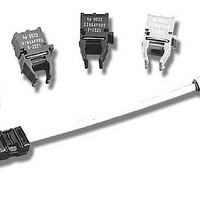HFBR-0564 Avago Technologies US Inc., HFBR-0564 Datasheet - Page 9

HFBR-0564
Manufacturer Part Number
HFBR-0564
Description
Fiber Optics, Evaluation Kit
Manufacturer
Avago Technologies US Inc.
Datasheet
1.HFBR-0562.pdf
(14 pages)
Specifications of HFBR-0564
Silicon Manufacturer
Avago
Silicon Core Number
HFBR-591xE
Kit Application Type
Communication & Networking
Application Sub Type
MT-RJ Gigabit Ethernet Transceiver
Main Purpose
Interface, Ethernet
Embedded
No
Utilized Ic / Part
HFCT-591xE, HFBR-591xE
Primary Attributes
MT-RJ Gigabit, Multimode and Singlemode Applications
Secondary Attributes
MT-RJ Fiber Connector Interface
Operating Voltage
3.3 V
Description/function
Fiber Optic Kit
Lead Free Status / RoHS Status
Lead free / RoHS Compliant
For Use With/related Products
HFBR-591x, HFCT-591
Lead Free Status / RoHS Status
Lead free / RoHS Compliant, Contains lead / RoHS non-compliant
MT-RJ SFF Panel Opening
Figure 10 shows the recommended
panel mounting for all Avago SFF
transceivers. This drawing precisely
follows the MSA’s drawing “Front
Panel Opening for MT-RJ”. All Avago
SFF transceivers, together with the
metal nose shield over the MT-RJ
connector port, will conform to this
front panel layout. The PCB must be
mounted perpendicular to the front
panel in order for the nose shield
chassis ‘fingers’ to fit correctly. Care
must be taken to slide the PCB hori-
zontally through the panel opening
and to avoid excessive pressure on
the nose of the transceiver.
The HFBR/HFCT-591xE transceivers
meet eye safety requirements, thus
avoiding the need for blocking the
optical ports when unconnected.
The port plugs supplied with SFF
transceivers are for protecting the
optics from contamination.
Optimum EMI performance requires
low impedance contact between
the MT-RJ metal nose shield and
Figure 10. Recommended panel mounting
Dimensions in millimeters (inches)
Note: Nose shield should be connected to chassis ground.
(0.425 ±0.004)
10.8 ±0.1
(0.55)
13.97
MIN.
(TOP OF PCB TO
(0.01 ±0.004)
BOTTOM OF
0.25 ±0.1
OPENING)
(0.386 ±0.004)
9.8 ±0.1
(0.15)
3.8
system chassis. The edges of the
panel opening should be free
from any non conductive paints or
adhesives. In addition metals that
can build up insulating oxides, such
as aluminium, should be avoided.
The SFF grounding scheme is de-
scribed in the relevant data sheets.
It is important to note that the
HFBR/HFCT-591xE transceivers have
separate V
ground planes for the transmitter
and receiver sections.
PCB Design Guideline
High-speed PCB design guidelines
and rules are well documented in
many references but are outlined
below as a brief guide for the new
fiber optic designer.
1. Make data lines transmission
lines of fixed impedance, such as
microstrip or stripline. This should
be done even if these trace lengths
are so short that the propagation
delay of the line is small relative
to the transition time of the
(0.039)
(0.589)
14.79
1
CC
planes but common
2. Keep data lines as short as possible
3. Keep differential data lines in
4. Place power supply filter circuits
5. Place data line terminations at the
6. Use a wide-area, continuous
signal. In general, microstrip lines
of 50 W impedance should be
used to help dominate parasitic
effects of the board and devices
on the signal quality (reflections,
ringing, distortion) and minimize
unwanted electrical noise.
and of equal length to minimize
pulse-width distortion of the
differential data lines. Load the
differential lines symmetrically to
prevent pulse-width distortion.
the same approximate location
to prevent unbalanced crosstalk
coupling. Use differential signals
to
Single-ended operation is not
recommended since data sheet
specifications can only be guaran-
teed when both differential
inputs are used.
as close as possible to the V
pins of the fiber optic transceiver
for best power supply conductive
noise filtering.
load end of the transmission line
where the input of the receiving
circuit is located.
ground plane to provide a low-
inductive impedance return path
for the power supply ground
currents. Minimize holes in the
ground plane to allow ground
currents to take direct paths to
the return point, and to form a
shielding plane and reference
plane for microstrip transmission
lines. It is possible to provide a cut
in the ground plane underneath
the fiber optic transceiver (along
the centerline of the length of
the device) from the front of the
transceiver to the rear end of the
transceiver. This cut does not
disconnect the ground plane into
independent sub-portions; the
ground plane is still one plane.
This cut merely causes logic
ground currents not to flow under
the sensitive receiver section of
the transceiver.
interconnect
components.
CC
























